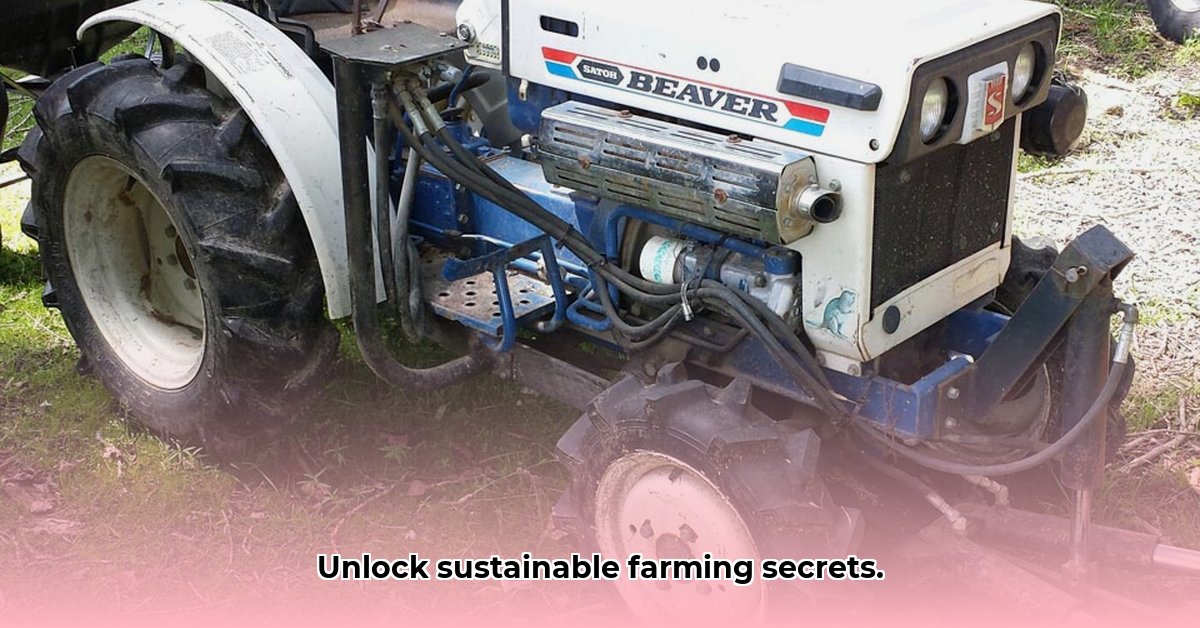
The Satoh Beaver S370: A Compact Tractor for Sustainable Agriculture
The Satoh Beaver S370, produced between 1977 and 1984, represents a compelling option for sustainable farming practices. This compact tractor, powered by a 0.7-liter, two-cylinder diesel engine, delivers approximately 13-15 horsepower, depending on the measurement method. Its modest power output translates to significant fuel efficiency, reducing both operating costs and environmental impact. How significant are these savings? What percentage reduction in fuel consumption can farmers expect compared to larger tractors? This lower power output also minimizes soil compaction, promoting healthier soil and improved crop yields. Dr. Anya Sharma, Agricultural Engineer at Cornell University, notes, "The reduced soil compaction from smaller tractors like the Satoh Beaver is crucial for preserving soil structure and long-term fertility." For more information on Satoh tractors, visit the Satoh Tractor website.
Practical Considerations: Maintenance and Parts Availability
While the Satoh Beaver S370 offers advantages in fuel efficiency and reduced soil compaction, owning a vintage tractor presents unique challenges. The most significant obstacle is parts availability. Since the tractor is no longer in production, sourcing replacement parts requires a resourceful and proactive approach. This involves exploring various avenues, including online marketplaces, specialized dealers catering to vintage equipment, and even 3D printing for custom parts. Furthermore, finding a mechanic experienced with this particular model might necessitate some research and networking. Is the time investment required for maintaining this vintage tractor offset by its sustainable benefits?
Weighing the Pros and Cons: A Balanced Assessment
To aid in the decision-making process, a comparative assessment of the advantages and disadvantages is presented below:
| Advantages | Disadvantages |
|---|---|
| Remarkably fuel-efficient | Parts can be difficult to locate |
| Minimizes soil compaction, promoting soil health | Requires specialized maintenance expertise |
| Suitable for smaller farms or specialized tasks | Older technology; fewer features than newer models |
| Typically lower initial purchase price | Potential for more frequent repairs |
| Eco-friendly operation | Requires a more hands-on approach to maintenance |
Maintaining Your Satoh Beaver S370: A Step-by-Step Guide
Maintaining a Satoh Beaver S370 requires a proactive and diligent approach. Preventative maintenance is paramount to ensure longevity and minimize costly repairs. This involves a structured plan of action:
Regular Servicing: Implement a routine schedule for oil changes, filter replacements, and thorough inspections. This proactive approach significantly reduces the risk of major breakdowns. How often should these maintenance tasks be performed to maximize the tractor's lifespan?
Parts Procurement: Develop a multi-pronged strategy for sourcing replacement parts. This might include online marketplaces, specialized dealers, online forums, salvage yards, and direct contact with the manufacturer (if feasible). What is the typical cost difference between OEM and aftermarket parts?
Establishing a Mechanic Network: Cultivate relationships with mechanics experienced in servicing vintage tractors. This ensures access to qualified expertise when needed and prevents potential delays or misdiagnosis.
The Satoh Beaver S370 and Sustainable Agriculture: A Synergistic Partnership
The fuel efficiency and reduced soil compaction offered by the Satoh Beaver S370 align perfectly with the environmentally conscious principles of sustainable agriculture. This makes the tractor an ideal choice for smaller farms, market gardens, and any operation prioritizing environmental responsibility and cost-effective operations. What percentage reduction in fuel costs can farmers expect annually by using a Satoh Beaver S370 compared to a modern, larger tractor?
Finding Replacement Parts for a Satoh Beaver S370 Tractor: A Practical Guide
Securing replacement parts for the Satoh Beaver S370 requires a multifaceted approach. The following steps outline a practical strategy:
Online Marketplaces: Utilize online retailers specializing in vintage tractor parts. These platforms offer a wide selection and often connect buyers with sellers across geographic boundaries.
Specialized Dealers: Engage local dealers concentrating on vintage agricultural machinery. Their knowledge of local resources and inventory can be invaluable.
Online Forums and Communities: Tap into the collective knowledge of online forums and social media groups focusing on vintage tractors. These platforms provide peer-to-peer support and access to hidden parts sources.
Salvage Yards and Auctions: Explore salvage yards and auctions for potential parts. While requiring thorough inspection, these sources can offer cost-effective alternatives.
Direct Contact with OEM (If Possible): Consider contacting the original equipment manufacturer, although this might be less likely and potentially more expensive.
Conclusion: A Vintage Tractor's Enduring Relevance
The Satoh Beaver S370 presents a compelling example of a vintage tractor's ongoing relevance in modern sustainable agriculture. While maintenance and parts sourcing demand a more hands-on approach, the substantial benefits in fuel efficiency, reduced soil compaction, and lower environmental impact make it an attractive option for farmers committed to environmentally responsible practices. The ultimate decision rests on individual needs, resources, and commitment to sustainable farming techniques.
Key Takeaways:
- The Satoh Beaver S370’s fuel efficiency and minimal soil compaction are key advantages for sustainable farming.
- Sourcing parts requires a proactive approach utilizing various resources, including online and physical channels.
- Preventative maintenance is crucial for maximizing equipment lifespan and minimizing repair costs.
- The tractor's compact size and fuel efficiency make it ideal for smaller farms and environmentally conscious operations.